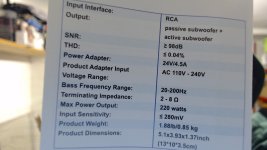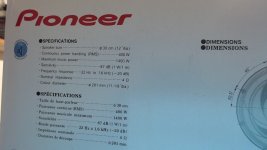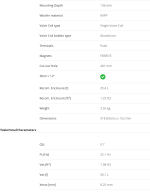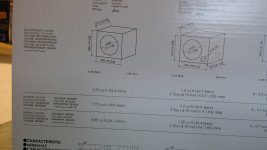Hi Folks, I bought the Pioneer TSA30S4 12inch driver to replace an old Gale one that lived in a ported cabinet, replaced the Amp with a Fosi Audio TP-02 sub amp. I'm getting a weird whistling ( port chuffing? ) noise at around 20-30hz it's pretty annoying. I'm not an expert, but I'm wondering if either the amp is not suitable or the driver is not working as it should. Please have a look at the vid and the amp specs attached. Any advice appreciated!
Thanks Dan
Thanks Dan
Attachments
Thanks, I've already tried blocking the port with a bunch of tea towels. Didn't really make any difference. I'll try the foam though, I guess it's different than blocking the port entirely. You think it's the port rather than the driver or amp?
Not likely to be the amplifier. Cut some foam that fits the port well and see if it helps.
If it cuts the bass too much, use a thinner piece of foam.
If it cuts the bass too much, use a thinner piece of foam.
The chassis may not seal at the circumference, the sound you hear is air being pressed through a small slot. And, no, it doesn't matter it is a vented cabinet, it has to be 100% air tight.
Sometimes the leads to the voice coil are touching the membrane/cone, making a similar sound. The video is not very usefull for a diagnose. You can correct this by carefully bending them away from any moving part.
Last, you have an amp with a 24V/4.5A power supply. Which may deliver 60 Watt rms at 1% distortion into 4 Ohms. So driving it at such low frequency with high excursion may result in audible distortion. Also, the chance that your woofer matches the tuning of some random cabinet is about 10.000 to 1 or worse.
The data you show help zero.
Sometimes the leads to the voice coil are touching the membrane/cone, making a similar sound. The video is not very usefull for a diagnose. You can correct this by carefully bending them away from any moving part.
Last, you have an amp with a 24V/4.5A power supply. Which may deliver 60 Watt rms at 1% distortion into 4 Ohms. So driving it at such low frequency with high excursion may result in audible distortion. Also, the chance that your woofer matches the tuning of some random cabinet is about 10.000 to 1 or worse.
The data you show help zero.
Thanks for the advice @rayma and @Turbowatch2, I didn't realise how many factors can affect getting a sub to sound good! I've tried foam in the port, it may have helped but I suspect the issues mentioned by @Turbowatch2 may be at play here. I know there are some smallish gaps that I can address ( the previous cabinet had an amp built into the back ) can you give me any tips to help achieve better tuning with the current cabinet / woofer combo? I don't want to buy another amp if I can avoid it. Thanks in advance
There is something called TSP, data that describe the behavior of a loudspeaker. If you get these 3 data (at last 3), which is Fs, Qts and Vas, you can tune the port for this volume. What we also need is the inner volume of the cabinet you have.
Close the amp hole with a piece of wood, about 3/4" or 18mm. You may simply cover the whole side it is on, which makes it look better than just a piece the amps size. Sorry you first bough the speaker and asked later. The other way round in general works better...
PS for a closed volume the power of the amp is much too low. The power supply shows the real Watt, the huge number on the advertising is just a lie. For a vented cabinet the 60 Watt can be enough.
Close the amp hole with a piece of wood, about 3/4" or 18mm. You may simply cover the whole side it is on, which makes it look better than just a piece the amps size. Sorry you first bough the speaker and asked later. The other way round in general works better...
PS for a closed volume the power of the amp is much too low. The power supply shows the real Watt, the huge number on the advertising is just a lie. For a vented cabinet the 60 Watt can be enough.
Thanks for the useful info @Turbowatch2 ! Sadly I'm stuck with these so am going to try make them sound as good as I can. I've attached the TSP data and some more enclosure details I found on the driver's packaging. The internal cabinet volume is 69 cubic litres, which is bigger than the maximum volume described in the spec. The port is 70mm ( diameter ) x 240mm length.
I will make sure there are no gaps in the enclosure. I'm wondering if it's possible to reduce the internal volume by adding something solid i.e. a brick / solid wood or is this silly idea? I appreciate your help! Cheers Dan
I will make sure there are no gaps in the enclosure. I'm wondering if it's possible to reduce the internal volume by adding something solid i.e. a brick / solid wood or is this silly idea? I appreciate your help! Cheers Dan
Attachments
Next: A car is no living room. Rules for building cabinets that give good bass in a very small room = car do not work in a house.
Which leads to the question what you need it for.
The TSP for the woofer are more suited for an car" free air" or livingroom "open baffle" installation, but not for closed or vented.
For a start, if the TSP are correct, You should be fine with the box as is, but use a vent a little shorter than Pioneer's for the large volume, like 76mm dia and 150 long. Maybe tell us what vent diameter you have in the box and we can figure what a promising length may be.
Best would to get a measuring microfone and adjust the length for something usefull.
Which leads to the question what you need it for.
The TSP for the woofer are more suited for an car" free air" or livingroom "open baffle" installation, but not for closed or vented.
For a start, if the TSP are correct, You should be fine with the box as is, but use a vent a little shorter than Pioneer's for the large volume, like 76mm dia and 150 long. Maybe tell us what vent diameter you have in the box and we can figure what a promising length may be.
Best would to get a measuring microfone and adjust the length for something usefull.
Hi, it will be used for mainly music and movies in a living room. So general use really. The existing port is 70mm ( diameter ) x 240mm length.
I don't understand your comment about the microphone?
Thanks Dan
I don't understand your comment about the microphone?
Thanks Dan
OK, you gave the data, I was a little distracted.
See, I often get presented stuff that is not really right for the task. Over the years one develops some way's to bend the rules a bit and maybe get something usable in the end.
The first approach is to beat bad tuning with power. Your 60 Watt amp is not what you take for that...
Next I distrust the Pioneer TSP. So when we install this woofer to your cabinet and try the nearest recommended vent, something should happen we can measure. I will explain a little later.
See, I often get presented stuff that is not really right for the task. Over the years one develops some way's to bend the rules a bit and maybe get something usable in the end.
The first approach is to beat bad tuning with power. Your 60 Watt amp is not what you take for that...
Next I distrust the Pioneer TSP. So when we install this woofer to your cabinet and try the nearest recommended vent, something should happen we can measure. I will explain a little later.
OK. Correct way, simplest, fastest and most promising:
Precondition woofer by letting it wobble with 35 Hz and some visible cone excursion for half an hour.
Measure TSP.
Put data in a simulation program, best for beginner is WinISD.
Simulate options with your cabinet volume.
Build it as simulated.
Listen to the result, but better measure with microfone and software. REW is best for beginner.
Modify if needed.
Precondition woofer by letting it wobble with 35 Hz and some visible cone excursion for half an hour.
Measure TSP.
Put data in a simulation program, best for beginner is WinISD.
Simulate options with your cabinet volume.
Build it as simulated.
Listen to the result, but better measure with microfone and software. REW is best for beginner.
Modify if needed.
You can do a quick try& error as well.
Shorten the 70mm vent to 10 cm.
Install driver in volume. Make it air tight, please! .
If this gives some useable bass, we hit the jack pot and the Pioneer data might be right.
As you only have 60 Watt, which will only give very little excursion, we can use parameter that are a little different to the "normal" for full power.
By the way, the amp is quite OK, imo the driver is the problem. Sad you did not take the similar priced Alpine SWG-1244. Probaply the best low cost woofer for sub use in the region up to 200€ or more.
Shorten the 70mm vent to 10 cm.
Install driver in volume. Make it air tight, please! .
If this gives some useable bass, we hit the jack pot and the Pioneer data might be right.
As you only have 60 Watt, which will only give very little excursion, we can use parameter that are a little different to the "normal" for full power.
By the way, the amp is quite OK, imo the driver is the problem. Sad you did not take the similar priced Alpine SWG-1244. Probaply the best low cost woofer for sub use in the region up to 200€ or more.
- Home
- Loudspeakers
- Subwoofers
- Pioneer TSA30S4 in ported cabinet 0 - Is my driver faulty? Whistling at ~20-30hz



